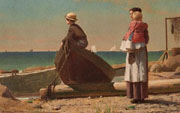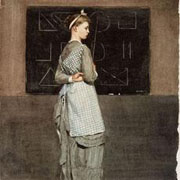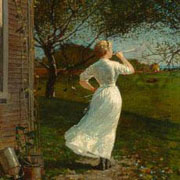VOA慢速英语2011--Winslow Homer, 1836-1910: America’s Painter
时间:2019-01-02 作者:英语课 分类:2011年VOA慢速英语(十一)月
PEOPLE IN AMERICA - Winslow Homer, 1836-1910: America’s Painter
STEVE EMBER: I’m Steve Ember.
BARBARA KLEIN: And I’m Barbara Klein with PEOPLE IN AMERICA in VOA Special English. Today we tell about Winslow Homer, considered to be the greatest American artist of the nineteenth century. Homer created pictures that showed the relationship between humans and nature. The strong, clear images he drew and painted matched the wild, developing and proud United States of the late eighteen hundreds.
(MUSIC)
STEVE EMBER: Winslow Homer was the second of three sons of Henrietta Benson and Charles Savage 1 Homer. He was born in Boston, Massachusetts in eighteen thirty-six and grew up in Cambridge. His father was an importer of tools and other goods. His mother was a painter. Winslow got his interest in drawing and painting from his mother. But his father also supported his son’s interest. Once, on a business trip to London, Charles Homer bought a set of drawing examples for his son to copy. Young Winslow used these to develop his early skill.
BARBARA KLEIN: Winslow’s older brother Charles went to Harvard University in Cambridge. The family expected Winslow would go, too. But, at the time, Harvard did not teach art. So Winslow’s father found him a job as an assistant in the trade of making and preparing pictures for printed media. At age nineteen, Winslow learned 2 the process of lithography. This work was the only formal training that Winslow ever received in art.

This Winslow Homer painting from 1873 is called "Dad's Coming!"
STEVE EMBER: Winslow did this work for about two years. Then the young man decided 3 to become an independent illustrator, someone who makes drawings and pictures for a living.
He worked in Boston for a few years, drawing illustrations 5 for stories in several newspapers. He also did work for a magazine that was different from any other of the time. Harper’s Weekly, in New York City, needed good illustrations and had lots of space for them. The young Winslow began to establish himself as an artist in demand.
BARBARA KLEIN: In eighteen fifty-nine, Winslow Homer moved to New York City to work for Harper’s Weekly. Homer also started to paint seriously. He hoped to go to Europe to study painting. But, something would intervene 6 that would change the direction of Winslow Homer’s artistic 7 work. Harper’s magazine would send him to draw pictures of the biggest event in American history since independence. It was the Civil War between the Union and the rebel 8 southern states.
(MUSIC)

Homer Winslow's watercolor on wove paper "Blackboard"
STEVE EMBER: Winslow Homer went to Washington, D.C., in eighteen sixty-one. He drew pictures of the campaign of Union Army General George McClellan the next year. His pictures of the war showed the many ways that conflicts affect people.
In one illustration 4, he showed Union soldiers on horses advancing heroically 9. The Southern Confederate soldiers are shown forced under the feet of the horses, while the horsemen hold their swords high. The illustration is called “The War for the Union, Eighteen Sixty-Two — A Cavalry 10 Charge.”
BARBARA KLEIN: In another famous illustration, “The Army of the Potomac — A Sharp-Shooter on Picket 11 Duty,” Homer showed a different side of war. A soldier sitting in a tree is holding a rifle 12. He is aiming at a target far in the distance. Many critics say the picture shows the cold, mechanical 13 nature of warfare 14, bringing death to the unsuspecting.
Winslow Homer also made a famous painting called “Home, Sweet Home.” It shows two soldiers listening to music played by military musicians. This was common during the Civil War. At the end of the day, musicians on both sides would play to raise the spirits of soldiers. Often they would play the song “Home, Sweet Home.”
(MUSIC)
Homer painted two Union soldiers preparing a meal. The musicians are in the distance. The two soldiers appear to be stopped in the middle of their preparations by thoughts of home and family.
(MUSIC)
STEVE EMBER: Critics widely praised Homer’s work during the Civil War. His work gained him membership 15 in what is now called the National Academy 16. One painting, “Prisoners from the Front,” was chosen to represent the United States at the Exposition 17 Universelle. This event was held in Paris, France in eighteen sixty-six. Homer went to Europe for the first time. However, little is known about his stay in Europe.

Often called the greatest American artist of the 1800s, here Winslow Homer's oil on canvas 18 "Home, Sweet Home"
BARBARA KLEIN: The next major change in Winslow Homer’s life was a decision to work in a new medium. Until now, Homer had used oil-based paints. Colorful substances are mixed with oil. These thick paints can be spread in layers, one over another, to produce interesting effects of light and color.
Oil paints are usually put on canvas cloth. Most people consider oil painting “serious painting.” But in the summer of eighteen seventy-three, Homer began using watercolor paint.
STEVE EMBER: Watercolor paint is color, or pigment 19, dissolved in water. The paint is thin. Sometimes you can see through the paint to the paper underneath 20. Watercolor paint can be used to color drawings or by itself. It is a much faster medium than oil painting. But it is a different and difficult skill to learn.
Homer’s decision to use watercolor may have been connected with another major decision. Two years after he started using watercolor, he stopped illustrating 21 for magazines like Harper’s. In doing so, he ended a good way to earn a living. Instead, he decided to make a living only from selling his paintings. He was completely independent. Just as he said he always wanted to be.
BARBARA KLEIN: One of Homer’s best paintings from this period is called “Breezing Up.” It was shown for the first time in eighteen seventy-six. It shows three boys and a man in a small sailboat. A strong wind fills the sails. The man pulls in the sail, causing the boat to gain speed. One of the boys holds the rudder, which controls the direction of the boat. The two other younger boys hold on for the ride.
“Breezing Up” is considered one of Homer’s finest paintings. Today, it is part of the permanent collection of the National Gallery of Art in Washington, D.C.
(MUSIC)
STEVE EMBER: In the late eighteen seventies, experts say Homer experienced 22 some kind of crisis 23. Before, he had been a very social person. But after this period, he withdrew 24 from social activities. Some critics say he had an unhappy relationship with a woman.
Whatever changed him, Homer must have felt a need to escape. He traveled to Britain in eighteen eighty-one. He spent most of his time in the fishing village of Cullercoats, near New Castle. There he painted many pictures of life and events on and near the sea.
BARBARA KLEIN: Homer returned to the United States the following year. He settled in Prouts Neck, Maine. He would call it home for the rest of his life. His brothers, Arthur and Charles, both owned houses there. It appeared that Homer withdrew from social life. He avoided visits from people wanting to meet America’s greatest living painter.

Winslow Homer's The Dinner Horn (Blowing the Horn at Seaside), 1870
But Homer’s later life was also filled with travel, which provided 25 subjects for his paintings. He visited warm places – Bermuda, the Bahamas, Cuba and the American state of Florida. He made several trips to fish and to paint. In these places, he used bright watercolor paints.
STEVE EMBER: Homer also spent time in the Adirondack Mountains in New York State. There he found rich subject matter in the people, hunters and wildlife of the area. But now, a new subject became more important in his work. As he grew older, Homer increasingly 26 painted subjects facing death.
One of Homer’s last paintings is called “Right and Left.” It shows two ducks that have just been shot by a hunter as they fly above the surface of a wide expanse of water. The painting is named for a hunter’s trick. It describes how a hunter can use both barrels 27 of a shotgun to bring down two birds very quickly.
In the painting, the water and sky are grey. It is very early in the morning. If you look carefully at the painting, you can see two small points of the color orange. Looking closer still, you can see that one is a small part of a rising sun. The other is more surprising. It is the firing of the shotgun.
Almost hidden behind one of the falling ducks is the boat carrying the hunter. Here, Homer did something very unusual. The observer 28 of the painting is directly in the line of gunfire.
BARBARA KLEIN: Winslow Homer died at Prouts Neck, Maine, in nineteen ten. He was firmly established as America’s greatest painter of the time.
(MUSIC)
STEVE EMBER: This program was written and produced by Mario Ritter. I’m Steve Ember.
BARBARA KLEIN: And I’m Barbara Klein. Join us again next week for PEOPLE IN AMERICA in VOA Special English.
- The poor man received a savage beating from the thugs.那可怜的人遭到暴徒的痛打。
- He has a savage temper.他脾气粗暴。
- He went into a rage when he learned about it.他听到这事后勃然大怒。
- In this little village,he passed for a learned man.在这个小村子里,他被视为有学问的人。
- This gave them a decided advantage over their opponents.这使他们比对手具有明显的优势。
- There is a decided difference between British and Chinese way of greeting.英国人和中国人打招呼的方式有很明显的区别。
- Illustration by example is better than explanation in words.用实例说明比用词语解释清楚。
- He used photographs as illustration for his talk.他用照片为他的演讲作图片说明。
- The otherwise dreary book is enlivened by some very amusing illustrations. 这本枯燥乏味的书幸亏加了一些精彩的插图才变得生动有趣。 来自《简明英汉词典》
- The illustrations were cleverly tied in with the text. 插图与本文配合得很巧妙。 来自《简明英汉词典》
- When riot broke out,the police were obliged to intervene.发生暴乱时,警察有责任干预。
- You don't intervene between those two drunks.你不要在那两个酒鬼之间进行调解。
- The picture on this screen is a good artistic work.这屏风上的画是件很好的艺术品。
- These artistic handicrafts are very popular with foreign friends.外国朋友很喜欢这些美术工艺品。
- The rebel army is attempting to subvert the government.反叛军队企图颠覆政府统治。
- The rebel army has readjusted its strategy.叛军已经重新调整了策略。
- Zoya heroically bore the torture that the Fascists inflicted upon her. 卓娅英勇地承受法西斯匪徒加在她身上的酷刑。 来自《简明英汉词典》
- They fought back heroically. 他们英勇反击。 来自《简明英汉词典》
- We were taken in flank by a troop of cavalry. 我们翼侧受到一队骑兵的袭击。
- The enemy cavalry rode our men down. 敌人的骑兵撞倒了我们的人。
- They marched to the factory and formed a picket.他们向工厂前进,并组成了纠察队。
- Some of the union members did not want to picket.工会的一些会员不想担任罢工纠察员。
- The soldiers keep a tight hold of the rifle.战士们紧握手中的枪。
- They armed him with a rifle.他们发给他一支步枪。
- He borrowed a mechanical book from me.他从我这儿借了一本力学方面的书。
- He looks very mechanical.他看上去非常呆板。
- He addressed the audience on the subject of atomic warfare.他向听众演讲有关原子战争的问题。
- Their struggle consists mainly in peasant guerrilla warfare.他们的斗争主要是农民游击战。
- I must renew my membership of the sailing club.我必须延续我的航海俱乐部会员的资格。
- He made up his mind to apply for membership in the Party.他决心申请入党。
- This is an academy of music.这是一所音乐专科学院。
- I visited Chinese Academy of Sciences yesterday.我昨天去访问了中国科学院。
- John gave a very exposition of the facts.约翰把事实解释得很清楚。
- His pictures were shown at the Paris exposition of 1878.他的画在1878年巴黎博览会上展览过。
- The times that people used canvas boat have become history.人们用帆船的时代已成为历史。
- Smith painted an oil painting on the canvas.史密斯在画布上画了一幅油画。
- The Romans used natural pigments on their fabrics and walls.古罗马人在织物和墙壁上使用天然颜料。
- Who thought he might know what the skin pigment phenomenon meant.他自认为可能知道皮肤色素出现这种现象到底是怎么回事。
- Working underneath the car is always a messy job.在汽车底下工作是件脏活。
- She wore a coat with a dress underneath.她穿着一件大衣,里面套着一条连衣裙。
- He upstaged the other speakers by illustrating his talk with slides. 他演讲中配上幻灯片,比其他演讲人更吸引听众。
- Material illustrating detailed structure of graptolites has been etched from limestone by means of hydrofluoric acid. 表明笔石详细构造的物质是利用氢氟酸从石灰岩中侵蚀出来。
- Experienced seamen will advise you about sailing in this weather.有经验的海员会告诉你在这种天气下的航行情况。
- Perhaps you and I had better change over;you are more experienced.也许我们的工作还是对换一下好,你比我更有经验。
- He had proved that he could be relied on in a crisis.他已表明,在紧要关头他是可以信赖的。
- The topic today centers about the crisis in the Middle East.今天课题的中心是中东危机。
- She withdrew to confer with her advisers before announcing a decision. 她先去请教顾问然后再宣布决定。 来自《简明英汉词典》
- She quickly withdrew her hand from the hot iron. 她很快地将手从火烫的熨斗上缩了回来。 来自《简明英汉词典》
- Provided it's fine we will have a pleasant holiday.如果天气良好,我们的假日将过得非常愉快。
- I will come provided that it's not raining tomorrow.如果明天不下雨,我就来。
- Rivers are being increasingly made use of by man. 河流正在日益为人类所利用。
- I find it increasingly difficult to live within my income.我发现靠收入过日子越来越难了。
- The farmers put up the apples in barrels. 农夫们把苹果装入箱内。 来自《简明英汉词典》
- The wine is aged for almost a year in oak barrels. 这葡萄酒已经在橡木桶里存放近一年了。 来自辞典例句